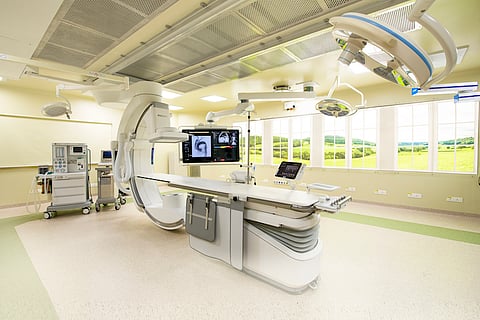

The past decade has seen Indian doctors take giant steps towards bringing world-class cardiac treatments to India, and some of the most cutting-edge procedures are now happening in our hospitals. Well-trained and highly-skilled, multi-specialty cardiac teams in India are now rubbing shoulders with the best doctors across the world, making India a global destination for patients requiring advanced cardiac care.
Take Dr AB Gopalamurugan at Kauvery Hospital in Chennai, for instance. He performed India’s first Transcatheter Mitral Valve Replacement (TMVR) procedure in 2017, and Tamil Nadu’s first Transcatheter Aortic Valve Replacement (TAVR) procedure in 2015. These procedures, known as Transcatheter Therapies, are done to replace defective heart valves without an open-heart surgery, making recovery significantly easier for the patient.
Heart procedures such as these, and many others, can be very complex. During a heart procedure, there is a risk of bleeding, infections, complications due to irregular heartbeat, heart electrical problems, and sometimes even a heart attack or a stroke. These happen very rarely, but the best medical teams are those which are prepared even for the rarest eventualities. Apart from the right doctors, the right equipment and high safety standards are required for all procedures to be successful. And that’s why, a Hybrid Operating Room is of utmost importance for any hospital with cardiac care.
Dr AB Gopalamurugan
What’s a Hybrid OR?
When doctors are operating on a patient, one of their main challenges is to have clear visibility at the microscopic level. There could be excessive bleeding or unnecessary tissue damage, and if the doctors can see better, they can do their jobs better. This is where a Hybrid OR come in.
A Hybrid OR is an operating room with sophisticated cameras which capture 3D images of the operating area on the patient’s body, magnify it and display it on a large screen in the operating room. These images guide surgeons during the operation. This way, there is reduced bleeding, less damage to surrounding tissue and the patient heals quickly.
“Patients may think of this as a simple improvement, but this can help doctors a lot while they are operating,” explains Dr AB Gopalamurugan, under whose aegis a new Hybrid Operating Room was inaugurated at Kauvery Hospital in Chennai recently.
Here are some of the most complex heart treatments which are now performed to save patients, and can be done at the Hybrid OR for better results.
Heart Electrical Treatments: The heart has a steady rhythm or beat, referred to as the ‘lub-dub’ sound. In some people, this rhythm becomes erratic. Over time, this can lead to fainting, a stroke, heart attack or even sudden death in the patient. When medicines do not work, surgeons give an electric shock to the heart using different techniques and instruments.
Complex Angioplasty: You may often hear the terms ‘bypass surgery’ or ‘stents’. These are needed when the arteries of the heart get blocked due to plaque build-up. There are various techniques to clear these blockages without an open-heart surgery, specialists can perform these complex procedures without opening the chest cavity.
Heart-valve Treatment without Open-heart Surgery (TAVI/TAVR): Blood that is purified with oxygen in the lungs comes to the heart. From here, it must be pumped into the aorta to supply pure blood to the rest of the body. A valve called Aortic valve regulates this flow. The Mitral valve and Tricuspid valve regulate flow of the blood in the two sides of the heart. When any of these valves don’t open properly, they need to be replaced – and now this can be done without an open-heart surgery. The procedures are called Transcatheter Mitral Valve Replacement, Transcatheter Aortic Valve Replacement or Transcatheter Tricuspid Valve Replacement.
Aortic Aneurysm Treatment without open surgery (ENAR/TEVAR): Aneurysm is the medical term for a balloon-like swelling or bump. When such bumps develop on the aortic wall, the person can suffer heart attack-like symptoms or shock. Endovascular Aneurysm Repair (ENAR) is a procedure to treat Aortic Aneurysms (AAA) without open-heart surgery.
Hybrid Aortic Surgery: When the aortic aneurysm, described above, is very large or complex in nature, minimally-invasive techniques (without open-heart surgery) may not work. Then a combination of open-heart surgery and minimally invasive procedure to place a stent is adopted. This is called Hybrid procedure, which minimises the risk of full-scale open-heart surgery while maximising the outcome.
This article was created by TNM Brand Studio in association with Kauvery Hospital, and not by TNM Editorial.